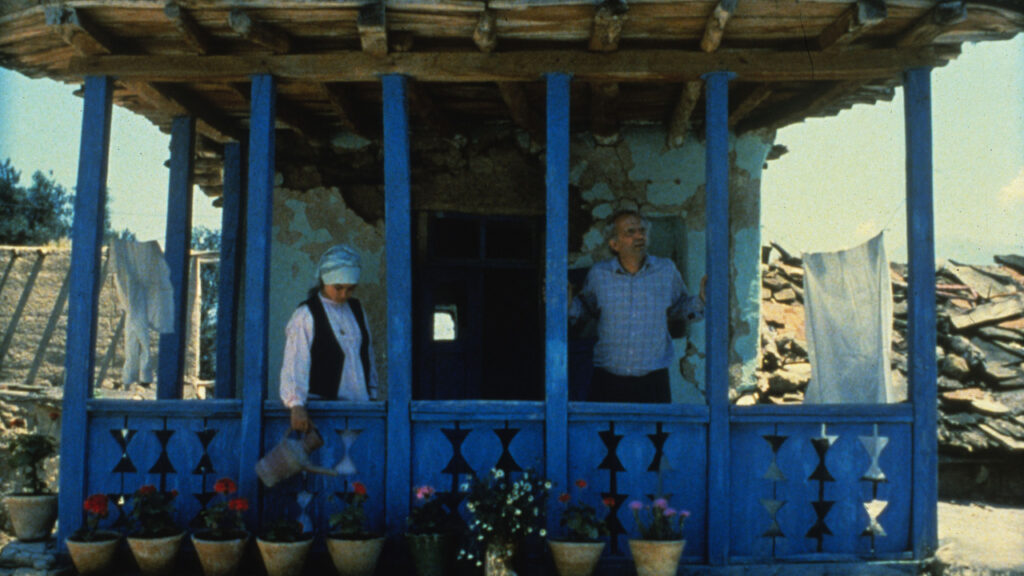When Abbas Kiarostami made Where Is the Friend’s Home?, he had no intention of making a trilogy. But his next two films, Life, and Nothing More… and Through the Olive Trees, were coined as such by critics; each exists as a fiction film within the other, and all are centered around the village of Koker. Friend’s Home is treated as a fiction within the world of Life, while a scene from Life is seen being filmed in Olive Trees. The ‘Koker Trilogy’ tag stuck, but Kiarostami has never endorsed it; he once stated that a more suitable grouping would include Life, Olive Trees, and 1998’s Taste of Cherry, three films thematically linked through their explorations of life versus death. Several scholars and critics are wary of the categorization because it emphasizes Kiarostami’s nonchalant, specious use of meta-narrative and downplays the unique thematic ideas represented in each of the three films.
Life, and Nothing More… loosely follows a man known to us only as “Film Director” (Farhad Kheradmand, acting as a stand-in for Kiarostami) and his young son, Puya (Buba Bayour), who journey to Koker with the intent of locating the child actors from Where Is the Friend’s Home?, amidst the aftermath of a ruinous earthquake. The real-life natural disaster this film makes reference to, the earthquake of 1990, had devastating effects on the village of Koker, where it claimed the lives of more than 50,000 residents, as well as on Iran’s collective national spirit (Kiarostami has even mentioned how personally he was stricken by the magnitude of its damage). The film’s events were restaged several months after the earthquake, which allowed Kiarostami time to contemplate its outcome instead of shooting what he felt might have resulted in sensationalist documentary footage; the film after all is based on a trip Kiarostami himself made after the quake to find the child actors of his earlier film. In spite of tragic losses, Kiarostami found the Koker people resilient, refusing to let their grief overcome them—they helped unearth bodies from the rubble, fed their neighbors and watched the World Cup.
These characters look forward to the future, they don’t dwell on the past. Life is an important film in Kiarostami’s oeuvre—it’s one of the earliest films to document Kiarostami’s fascination with life and death.
Kiarostami’s stand-in remains quietly troubled throughout Life, especially when speaking with the villagers. Puya, a deeply optimistic soul, remains preoccupied with the World Cup, even bringing up the topic when talking to kids he befriends in Koker. His new friends turn out to be operating on the same wavelength; when Film Director asks a young hitchhiker about the earthquake, the kid mistakes the question for an update on the Brazil-Scotland match. As in Friend’s Home, Kiarostami relies on the innocence of children to make some valid points about life: while it first appears that Film Director, an adult, is in control here, we gradually realize that Puya does all the “driving.” It’s Puya who is more willing to accept the natural disaster as a random event, “like a mad dog that attacks whoever is nearest while people who are further away escape.” He tells a mother mourning her lost daughter that at least now she won’t have to worry about her homework.
It would be tactless for an adult to say anything like this. However, a child’s simple perspective offers a vital kind of hope. When Film Director finds another child actor from Friend’s Home and comments on his physical size, the boy responds with “We all grow, right?” These characters look forward to the future, they don’t dwell on the past. Life is an important film in Kiarostami’s oeuvre—it’s one of the earliest films to document Kiarostami’s fascination with life and death. The theme is more compellingly explored in Taste of Cherry, but Life is almost equally captivating in its historical snapshot of an Iran coping with the fallout of a natural disaster which forced its citizens to deal with their cultural demons and find the courage to move on.


Comments are closed.